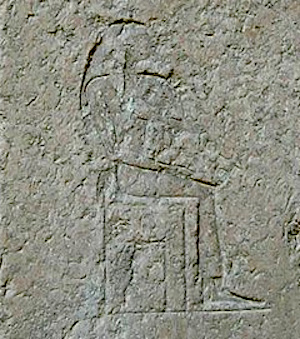Khentkaus I was a queen of Egypt towards the end of the fourth dynasty of the Old Kingdom. Her family relationships are not entirely clear, and there is some tantalizing, but inconclusive, evidence that she may have ruled Egypt as a regent for her son or in her own right.

Khentkaus I is the owner of a large burial enclosure at Giza which was originally thought to be an unfinished pyramid (designated LG100 and G8400). On the granite doorway to the valley temple of her stepped tomb at Giza there is an image of the queen along with an inscription. She is seated on a throne wearing the vulture diadem and Ureas, along with a short ritual beard and holding in her hand a Hetes Scepter – all royal emblems worn by a king of Egypt.
Then there is the matter of the inscription. Her title, “mut nesu-bity nesu-bity”, can be translated as either “Mother of Two Kings of Upper and Lower Egypt” or “Mother of the King of Upper and Lower Egypt, and King of Upper and Lower Egypt”. It seems that the image was altered to show her in the form of a king, and her pyramid complex was enlarged towards the beginning of the fifth dynasty, prompting the suggestion that she took over as ruler (possibly as regent for her son) on the death of her husband.
This brings us to the quandary known as the “Khentkaus Problem”. Were Khentkaus I and Khentkaus II the same person or were there two queens with the same name, separated by one or two generations, both of whom used this controversial title and both of whom ruled Egypt? Excavation of the pyramids and enclosures at Abusir and Giza strongly suggests that there were two queens with the name Khentkaus, but to be sure we have to try to clarify the family relationships.
In the case of Khentkaus II, it is reasonably certain that she was the wife Neferirkare and the mother of two kings, Neferefre and Niuserre. However, the situation is not so clear for Khentkaus I. Numerous possibilities have been proposed…
- Khentkaus was the daughter of Menkaure and the wife of Shepseskhaf and Userkhaf (Hassan)
- Khentkaus was the daughter of Menkaure and the wife and sister of Shepseskhaf and the wife of Userkhaf (Grdseloff)
- Khentkaus was the daughter of Menkaure and the sister of Shepseskhaf (Junker)
- Khentkaus was the daughter of Menkaure, the wife of Shepseskhaf, and the mother of Sahure and Neferirkare (Borchardt)
- Khentkaus was Reddjedet from the Westcar Papyrus and the mother of Userkhaf, Sahure and Neferirkare (Altenmuller)
- Khentkaus was the daughter of Menkaure and the wife and half-sister of Shepseskhaf and she married the High Priest of Re to secure the throne for her two sons on his death (Kozloff)
- Khentkaus was the daughter of Menkaure, the wife of Shepseskhaf, and the mother of Userkhaf and Sahure (Callender)
- Khentkaus was the wife of Userkhaf, and the mother of Sahure and Neferirkare, or she was the mother of Userkhaf or Sahure (Dodson)
Ultimately, we don’t have enough information to confirm the family relationships, but there is enough to suggest there were indeed two queens named Khentkaus.
As to whether Khentkau ruled Egypt as a queen regent or a female pharaoh, again there is insufficient evidence to be certain. The image of her wearing the ritual beard and ureas is compelling, and her pyramid and mortuary complex certainly confirm that she was a person of some importance. However, her name does not appear in a cartouche and is not listed on any kings list.
Bibliography
- Bard, Kathryn (2008) An introduction to the Archaeology of Ancient Egypt
- Dodson, A and Hilton, D. (2004) The Complete Royal Families of Ancient Egypt
- Hawass, Zahi (2009) Silent Images: Women in Pharanoic Egypt
- Kemp, Barry J (1991) Ancient Egypt: Anatomy of a Civilisation
- Lehner, Mark (1997) The Complete Pyramids
- Malek, Jaromir (2000) “The Old Kingdom”, in The Oxford History of Ancient Egypt Ed I. Shaw
- Tyldesley, Joyce (2006) Chronicle of the Queens of Egypt
- Verner, Miroslav (2001) The Pyramids
- Verner, Miroslav (2002) Abusir : Realm of Osiris
- Wilkinson, Toby (2010) The Rise and Fall of Ancient Egypt
Copyright J Hill 2017